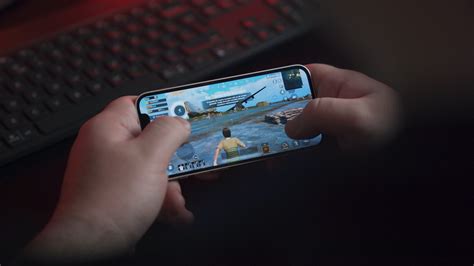Breaking News


Popular News


Explore the evolution of mobile gaming from early technology to virtual reality and the future of smartphone gaming.Mobile gaming has come a long way since the days of playing Snake on a classic Nokia phone. The evolution of mobile gaming has been nothing short of revolutionary, with advancements in technology and gameplay transforming the way we play and interact with games on our mobile devices. In this blog post, we will explore the fascinating journey of mobile gaming, from its humble beginnings to the exciting possibilities of virtual reality. We will delve into the early technology that paved the way for mobile gaming, the significant advancements that have shaped the industry, and the rise of smartphone gaming as a dominant force. Additionally, we will discuss the integration of virtual reality into mobile gaming and consider the potential future developments in this rapidly evolving space. Join us as we take a closer look at the evolution of mobile gaming and the exciting prospects that lie ahead.
Contents

Mobile gaming has become an integral part of our daily lives, with millions of people across the globe spending hours each day immersed in virtual worlds on their smartphones. The popularization of mobile gaming can be attributed to the advancements in technology, providing us with powerful devices that are capable of delivering high-quality gaming experiences right at our fingertips.
With the introduction of smartphones, mobile gaming has gone through a significant transformation, from simple Snake and Tetris games to immersive experiences that rival traditional gaming platforms. The sheer convenience of being able to play games on the go has led to a massive increase in the number of mobile gamers, making it one of the fastest-growing sectors in the gaming industry.
As mobile gaming continues to evolve, it is important to recognize its impact on the way we consume entertainment. The availability of a wide variety of games, ranging from casual puzzles to complex multiplayer experiences, has made mobile gaming accessible to people of all ages and backgrounds. Additionally, the integration of social features and in-app purchases has created new monetization opportunities for developers, further fueling the growth of the mobile gaming market.

Early mobile gaming technology can be traced back to the late 1990s and early 2000s when mobile phones were beginning to incorporate simple games such as Snake and Tetris. These games were often pre-installed on the devices, offering users a way to pass the time while on the go. The technology at the time was limited, with small screens and basic graphics, but these early mobile games paved the way for the future of mobile gaming.
As mobile phone technology began to advance, so did the capabilities of mobile gaming. The introduction of color screens and improved processing power allowed for more complex games to be developed. Java-based games became popular, providing users with a wider variety of gaming options. This era also saw the rise of multiplayer mobile games, allowing users to compete with each other over a wireless connection.
In addition to improved hardware, the early 2000s also saw advancements in mobile gaming software. Developers began to create more sophisticated game engines and tools, resulting in higher quality graphics and gameplay. This led to the release of iconic mobile games such as Space Impact and Bejeweled, which showcased the potential of mobile gaming as a viable form of entertainment.
| Advancements | Impact |
|---|---|
| Color screens and improved processing power | Allowed for more complex games and improved user experience |
| Java-based games | Expanded gaming options and introduced multiplayer capabilities |
| Development of sophisticated game engines | Resulted in higher quality graphics and gameplay |
Overall, the early mobile gaming technology laid the foundation for the thriving industry we see today. Without the innovations of the past, we wouldn’t have the immersive and diverse mobile gaming experiences that are available to us now.

The advancements in mobile gaming technology have been nothing short of remarkable. From the early days of simple, pixelated games like Snake on old mobile phones, to the current era of high-definition, immersive experiences on smartphones and tablets, the progress has been staggering.
One of the most significant advancements in mobile gaming has been the introduction of Augmented Reality (AR) and Virtual Reality (VR) technologies. These innovations have allowed developers to create games that blur the line between the digital and physical worlds, offering players unprecedented levels of immersion and interactivity.
Another key advancement in mobile gaming has been the shift towards cloud-based gaming. This technology allows players to access and play games from a remote server, eliminating the need for powerful hardware and allowing for seamless gaming experiences across multiple devices.
Furthermore, the integration of artificial intelligence and machine learning into mobile games has transformed the way games are played and experienced. These technologies enable game developers to create more dynamic and responsive gameplay experiences, making games feel more personalized and engaging for players.

Smartphone gaming has come a long way since the release of the first iPhone in 2007. With the advancement of technology and the widespread use of smartphones, mobile gaming has become a major player in the gaming industry. Today, millions of people around the world are playing games on their smartphones, whether it’s a quick puzzle game during their commute or a more immersive experience at home.
With the rise of smartphone gaming, game developers have been able to tap into a larger market and create games that are specifically tailored for mobile devices. The convenience and portability of smartphones have made gaming more accessible to a wider audience, leading to a surge in the popularity of mobile gaming.
Mobile gaming has also seen significant improvements in graphics, gameplay, and overall performance over the years. With more powerful hardware and advanced software, smartphones are now capable of delivering console-quality gaming experiences. This has attracted both casual gamers and dedicated gaming enthusiasts to the world of smartphone gaming, further cementing its position in the gaming industry.
As technology continues to evolve, the future of smartphone gaming looks promising. With the integration of augmented reality (AR) and virtual reality (VR) technologies, smartphone gaming is expected to become even more immersive and interactive. The rise of smartphone gaming has undoubtedly revolutionized the way we play and experience games, and its impact on the gaming industry is only expected to grow in the coming years.

Virtual reality (VR) has been a game-changer in the world of mobile gaming. The integration of VR technology into mobile devices has transformed the way people experience games on their smartphones and tablets. With the use of specialized headsets, VR takes players into an immersive and interactive 3D environment, providing a much more engaging and realistic gaming experience.
One of the key advantages of VR in mobile gaming is the level of immersion it offers. Players can feel like they are truly inside the game, interacting with the environment and characters in a way that was not possible before. This level of immersion enhances the overall gaming experience and opens up new possibilities for game developers to create unique and innovative games.
Furthermore, VR technology has the potential to revolutionize the way players interact with their mobile devices. Instead of simply tapping on a screen, users can physically move and interact with the VR environment using gestures and motions, making the gaming experience even more intuitive and natural.
| Benefits of VR in Mobile Gaming |
|---|
| Enhanced immersion |
| Unique gaming experiences |
| Intuitive interactions |

The future of mobile gaming is looking bright, with technology advancing at an unprecedented rate. As smartphones become more powerful and capable of handling complex graphics and gameplay, the potential for mobile gaming is expanding. With the introduction of 5G technology, the speed and connectivity of mobile devices will only improve, allowing for even more immersive gaming experiences.
In addition to improved hardware, the future of mobile gaming will also be shaped by virtual reality (VR) technology. With the development of affordable VR headsets and compatible mobile devices, players can expect to be fully immersed in their favorite games. This level of immersion will revolutionize the way we interact with mobile games, bringing a whole new level of realism and excitement to the gaming experience.
Another aspect of the future of mobile gaming is the potential for cross-platform gaming. As more games become compatible across different devices, players will be able to seamlessly transition between their smartphone, tablet, and even gaming console, without losing progress or functionality. This level of accessibility and flexibility will make gaming more convenient and enjoyable for players of all kinds.
| Advancements | Impacts |
|---|---|
| 5G Technology | Improved speed and connectivity for more immersive gaming experiences |
| Virtual Reality | Revolutionizing the way we interact with mobile games |
| Cross-Platform Gaming | Enhanced accessibility and convenience for players |

What was the first mobile game ever created?
The first mobile game ever created was Snake, which was pre-loaded on Nokia phones in the late 1990s.
How has mobile gaming evolved over the years?
Mobile gaming has evolved from simple pixelated games like Snake to high-definition, immersive experiences with the introduction of virtual reality technology.
What are some popular mobile gaming genres?
Some popular mobile gaming genres include puzzle games, strategy games, role-playing games, and multiplayer online battle arena (MOBA) games.
What impact has mobile gaming had on the gaming industry?
Mobile gaming has significantly expanded the gaming audience and has contributed to the overall growth of the gaming industry.
What are some technological advancements that have enhanced mobile gaming?
Technological advancements such as improved graphics processing, augmented reality, and cloud gaming have enhanced the mobile gaming experience.
What are the benefits of mobile gaming?
The benefits of mobile gaming include portability, accessibility, and the ability to connect with a global community of gamers.
What does the future of mobile gaming look like?
The future of mobile gaming looks promising with the continued development of augmented reality, virtual reality, and other innovative technologies.